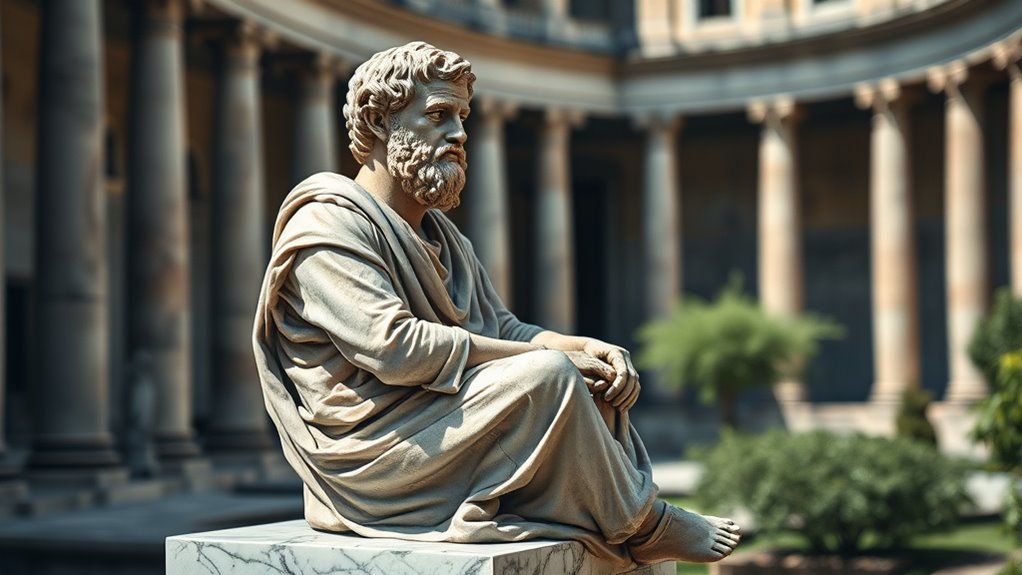Stoicism is an ancient philosophy that teaches you to live with virtue, resilience, and inner peace. It emphasizes focusing on what you can control—your thoughts, actions, and attitudes—and accepting what you can’t, like external events. By practicing mindfulness and emotional regulation, you learn to handle life’s challenges calmly. If you want to discover how to apply these ideas daily and build a stronger, more peaceful mindset, there’s much more to explore.
Key Takeaways
- Stoicism is an ancient philosophy that teaches living in harmony with nature and focusing on what you can control.
- It emphasizes virtues like wisdom, courage, justice, and temperance as guides for daily life.
- The philosophy encourages accepting external events and maintaining inner peace regardless of circumstances.
- Emotional regulation through mindfulness and reflection helps manage reactions and foster resilience.
- Practicing Stoicism involves differentiating between controllable thoughts and actions versus external factors beyond control.
The Origins of Stoicism

Have you ever wondered where Stoicism began? It all started in ancient Greece around 300 BCE, in the bustling city of Athens. It was founded by Zeno of Citium, who was inspired by earlier philosophies like Cynicism and Socratic teachings. Zeno taught that living in harmony with nature and accepting what you can’t control leads to happiness. He gathered a group of followers in the Stoa Poikile, a painted porch, giving the philosophy its name. Over time, Stoicism spread across Greece and later Rome, influencing many thinkers and leaders. Its core ideas about resilience, self-control, and virtue have endured for centuries, making it one of the most practical philosophies for steering through life’s challenges. The origins of Stoicism can be traced back to its founder, Zeno, and the cultural influences of ancient Greece. Additionally, the emphasis on personal virtue remains central to Stoic practice today, reflecting its lasting relevance in modern life. The philosophy also emphasizes living in accordance with nature, promoting harmony between individuals and the universe. Understanding the historical context of Stoicism helps us appreciate its enduring appeal and practical wisdom. Recognizing its cultural roots highlights how Stoicism has adapted across different eras while maintaining its fundamental principles.
Key Figures in Stoic Philosophy

Several influential figures shaped Stoic philosophy, each contributing unique insights that still resonate today. Zeno of Citium founded Stoicism around 300 BCE, teaching that virtue and reason are central to a good life.
Cleanthes, his successor, emphasized the importance of inner strength and moral integrity. Chrysippus expanded Stoic logic and ethics, making the philosophy more systematic and practical.
Marcus Aurelius, a Roman emperor, practiced Stoicism personally and wrote “Meditations,” reflecting on self-discipline and resilience. Epictetus, a former slave, focused on controlling what’s within your power and accepting what isn’t.
Additionally, understanding the role of logic and ethics in Stoicism helps clarify how these thinkers developed their ideas and applied them to daily life. These figures laid the groundwork for Stoicism, shaping its core ideas and inspiring countless followers to pursue virtue, tranquility, and wisdom in everyday life.
Core Principles and Ideas

The influential figures of Stoicism developed core ideas that continue to guide practitioners today. Central to these is the belief that your thoughts shape your emotions and actions. You should focus on what you can control—your judgments, choices, and responses—while accepting what’s outside your influence. This mindset helps you maintain inner peace amid external chaos. Embracing thoughts and emotions as within your control allows for greater resilience and clarity. Another key idea is living in harmony with nature, meaning you accept life’s natural course and embrace virtue as the highest good. Stoicism also emphasizes practicing wisdom, courage, justice, and temperance. By aligning your daily actions with these principles, you cultivate resilience and tranquility. Recognizing sound healing science can deepen your understanding of how external stimuli influence your mental state and promote well-being. Incorporating mindfulness practices can enhance your ability to stay present and respond thoughtfully to challenges. Developing an awareness of emotional regulation techniques can further strengthen your capacity to manage reactions and maintain equanimity. Understanding the importance of practical application in daily life can deepen your grasp of Stoic teachings and foster true inner strength.
The Role of Virtue in Stoicism

Virtue isn’t just about moral perfection; it’s about acting rightly regardless of external circumstances. You understand that true happiness doesn’t come from wealth, fame, or pleasure, but from living virtuously. Developing these virtues often requires consistent effort and self-awareness, which can be strengthened through daily reflection and practice self-discipline. By cultivating these qualities, you build resilience against life’s challenges and remain steady amid chaos. Virtue guides your choices and helps you maintain integrity, ensuring that your character remains strong no matter what life throws at you. Hackathons can serve as a platform to practice virtues like teamwork, perseverance, and innovation in a collaborative environment. Engaging in activities such as electric bikes demonstrates the importance of adaptability and resourcefulness, aligning with virtuous living. Embracing creative practice can further enhance your ability to think flexibly and adaptively, qualities essential for virtuous living. Ultimately, virtue becomes your compass for a meaningful, contented life.
How Stoics View Emotions

You naturally experience emotions as reactions to events, but Stoics believe you can control how you respond. They see feelings as natural, yet emphasize the importance of managing emotional triggers. Incorporating aromatherapy techniques such as diffusers or massage can help create a calming environment that supports emotional regulation. Additionally, understanding the role of emotional triggers can aid in recognizing and mitigating their impact on your reactions. Utilizing essential oils for emotional balance may further enhance your ability to maintain composure during challenging situations. Recognizing how Gold IRA Rollovers provide a means for financial security can also help reduce stress related to future uncertainties. Developing awareness of market volatility can further assist in emotional management during unpredictable financial times.
Emotions as Natural Responses
Although emotions can feel overwhelming, Stoics see them as natural responses rather than enemies to be suppressed. They recognize that feelings like anger, joy, or fear are part of human nature. Instead of fighting them, Stoics suggest understanding their origins and accepting them as signals about your perceptions. Emotions reveal your judgments; recognizing this helps you respond wisely. Recognizing emotional dysregulation can aid in managing personal reactions more effectively. Here’s a quick look: understanding credit card terms can aid in managing personal finance more effectively.
Control Over Emotional Triggers
While emotions are natural responses, Stoics believe you have the power to influence how much they control you. They teach that emotional triggers stem from your judgments and perceptions, not external events themselves.
By examining your reactions, you can identify the thoughts that spark strong feelings. The key is to pause and question whether your response is proportional or based on false assumptions.
Practicing mindfulness helps you recognize these triggers before emotions take over. Over time, you learn to reframe your judgments, reducing the intensity of emotional reactions.
This doesn’t mean suppressing feelings but gaining control over how you respond. Ultimately, Stoicism empowers you to maintain inner peace by managing emotional triggers rather than being driven blindly by them.
Differentiating Feeling and Judgment
Understanding the difference between feelings and judgments is key to applying Stoic principles to emotions. Feelings are your immediate emotional responses—like anger or joy—that arise naturally.
Judgments, however, are your interpretations or beliefs about those feelings or situations. For example, feeling annoyed might stem from judging a situation as unfair.
As a Stoic, you learn to recognize that feelings are automatic, but judgments are within your control. By examining your thoughts, you can decide whether your interpretation is rational or distorted.
This awareness helps you respond thoughtfully instead of reacting impulsively. Ultimately, differentiating feelings from judgments empowers you to manage emotions effectively, fostering a calmer, more rational approach to life’s challenges.
The Practice of Mindfulness and Reflection

Have you ever paused to contemplate how your thoughts and feelings influence your reactions? Practicing mindfulness and reflection helps you become aware of these internal processes.
By regularly observing your mind, you can identify automatic responses and choose more thoughtful reactions. To incorporate this into your life:
- Set aside a few minutes daily to meditate or breathe deeply, grounding yourself in the present.
- Keep a journal to reflect on your experiences, noting patterns in your thoughts and emotions.
- Ask yourself questions like, “Why did I react that way?” to gain insight and develop self-awareness.
This practice strengthens your ability to stay calm and rational, aligning perfectly with Stoic principles of control and virtue.
Over time, it cultivates a more centered, mindful approach to everyday life.
Differentiating Between What We Can and Cannot Control

Recognizing the difference between what you can and cannot control is fundamental to practicing Stoicism effectively. When you focus on what’s within your power, like your thoughts, actions, and reactions, you avoid unnecessary stress. Conversely, accepting what’s outside your control—such as others’ opinions or external events—prevents frustration.
| Can Control | Cannot Control |
|---|---|
| Your choices and efforts | Others’ reactions and beliefs |
| Your attitude and responses | Weather or natural events |
| Your habits and discipline | Past mistakes or failures |
| Your goals and intentions | Random accidents |
Stoicism in Daily Life

In daily life, practicing Stoicism means applying its principles to real-world situations to stay centered and resilient. You can start by:
- Controlling your reactions – When faced with challenges or setbacks, pause and choose a calm response instead of reacting impulsively.
- Practicing gratitude – Focus on what you have, not what’s lacking, to foster contentment and reduce frustration.
- Reflecting daily – Spend a few minutes reviewing your actions and thoughts, learning from experiences to improve your emotional resilience.
These habits help you maintain perspective, handle stress better, and stay aligned with Stoic ideals.
Consistent effort turns philosophical principles into practical tools for everyday life.
Common Misconceptions About Stoicism

Many people think Stoicism is about being pessimistic or resigned, but that’s a misconception. It’s not about suppressing emotions or pretending everything’s fine; it’s about understanding and managing your reactions.
Recognizing this helps you see how Stoicism can empower you, not dampen your outlook.
Stoicism Is Not Pessimism
A common misconception about Stoicism is that it promotes pessimism or resignation in the face of life’s challenges.
In reality, Stoicism encourages resilience and acceptance, not despair. It teaches you to focus on what you can control and to respond wisely, rather than giving in to negativity.
Here are three ways Stoicism differs from pessimism:
- It emphasizes personal growth and virtue, even amid difficulties.
- It fosters a mindset of gratitude and acceptance, not defeat.
- It seeks to empower you to face adversity with calm and clarity, rather than hopelessness.
It’s Not About Suppression
Some people mistake Stoicism for encouraging emotional suppression or ignoring feelings altogether. But that’s not true.
Stoicism isn’t about bottling up emotions or pretending they don’t exist. Instead, it teaches you to acknowledge your feelings without letting them control your actions. You learn to observe your emotions calmly, understand their roots, and choose responses that align with your values.
Suppressing feelings can be harmful and unnatural, while Stoic practice aims for healthy emotional awareness. It’s about developing resilience, not shutting down.
Starting Your Stoic Journey

Are you ready to begin your journey into Stoicism? Starting can feel overwhelming, but taking small steps makes it manageable. Here are three ways to get started:
Begin your Stoic journey with small steps: read, reflect, and apply core principles daily.
- Read foundational texts like Marcus Aurelius’ *Meditations* or Epictetus’ *Discourses*. Familiarize yourself with core ideas.
- Practice daily reflection. Spend a few minutes each day contemplating what’s within your control and what’s not.
- Apply Stoic principles in real situations. When faced with challenges, pause, breathe, and choose a rational response instead of reacting impulsively.
Frequently Asked Questions
How Does Stoicism Compare to Other Ancient Philosophies?
Imagine a vast garden of ancient philosophies, each with its unique flowers. Stoicism stands tall like a resilient oak, emphasizing inner strength and control amid stormy weather.
Unlike Epicureanism’s sweet fruit of pleasure or Skepticism’s fog of doubt, stoicism invites you to cultivate calmness and wisdom regardless of external chaos. You’re encouraged to focus on your reactions, building a sturdy mental fortress that withstands life’s tempests.
Can Stoicism Be Practiced Alongside Religious Beliefs?
Yes, you can practice Stoicism alongside religious beliefs.
Stoicism focuses on personal virtue, resilience, and rationality, which often complement many faiths’ moral teachings.
You might find that Stoic practices like mindfulness and acceptance enhance your spiritual life, helping you handle life’s challenges with calm and clarity.
Many people successfully integrate both, seeing Stoicism as a practical philosophy that supports and deepens their religious faith.
Is Stoicism Suitable for Modern Mental Health Challenges?
You’ll find that stoicism is quite suitable for modern mental health challenges. It teaches you to focus on what you can control, manage your reactions, and develop resilience.
By practicing mindfulness and acceptance, you can reduce stress, improve emotional regulation, and build inner strength.
Many find that integrating stoic principles helps them navigate anxiety, depression, and uncertainties more effectively, making it a valuable tool for mental well-being today.
What Are Common Mistakes Beginners Make When Practicing Stoicism?
You might stumble like a sailor caught in a storm when practicing stoicism. Common mistakes include trying to suppress emotions instead of understanding them, or applying the philosophy rigidly without flexibility.
You may also overlook the importance of compassion and connection, thinking it’s all about control. Remember, it’s about steering life’s waves with resilience, not building walls.
Be patient, adapt, and embrace the journey of growth.
How Long Does It Typically Take to See Benefits From Stoic Practices?
You might start noticing benefits from Stoic practices within a few weeks, especially if you’re consistent. While some see quick improvements in your mindset and emotional resilience, others may take several months to experience lasting change.
Keep practicing daily, reflect on your progress, and be patient. The key is persistence, as the more you apply Stoic principles, the more natural they become, leading to noticeable positive shifts over time.
Conclusion
Imagine you’re sailing through a stormy sea, with waves crashing all around. Embracing stoicism is like learning to steer your boat with calm and steady hands, regardless of the storm. By understanding what you can control and practicing virtue, you become the captain of your own life. Start today, and you’ll find that even in rough waters, you can navigate with resilience and peace, turning chaos into clarity.









